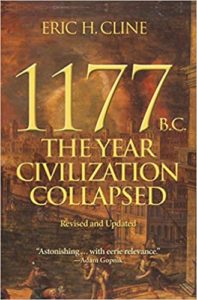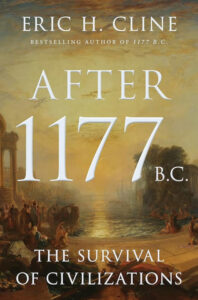Paralelamente à decadência da antiga ordem da Idade do Bronze Recente, grupos “etnicamente” definidos começam a aparecer em textos contemporâneos e posteriores. Estamos falando de grupos pertencentes aos “povos do mar”, com destaque para os filisteus, mas também de povos que vão se consolidando durante a Idade do Ferro, como os fenícios, israelitas, arameus, moabitas, amonitas, edomitas e outros.
como os fenícios, israelitas, arameus, moabitas, amonitas, edomitas e outros.
As ações de Tiglat-Pileser I (1115-1076 a.C.) prenunciam o que ocorrerá repetidamente nos próximos séculos, especialmente os assírios atacando as pequenas cidades-estado e reinos da Idade do Ferro que substituíram os impérios da Idade do Bronze em todo o antigo Oriente Médio. Algumas delas foram estabelecidas já no final do século XII a. C., mas outras só foram implementadas nos séculos XI, X ou IX a. C.
Entre estes reinos estava toda uma série de entidades políticas e várias etnias: cidades-estado siro-anatólias ou siro-hititas, como Carquemis, Aleppo, Sam’al (moderna Zincirli ) e Til Barsip no que hoje é o norte da Síria e na fronteira com a Turquia; bem como outros, como Que, que se localizavam na região da Cilícia (atual sudeste da Turquia); cidades-estado aramaicas, como Damasco e Hamate, no que hoje é a Síria; os enclaves fenícios de Tiro, Biblos, Sídon, Arwad e Beirute, onde hoje é a costa do Líbano; as cidades filisteias e os reinos de Israel e Judá no que hoje é o atual Israel e a Cisjordânia; e os outros pequenos reinos da época, como Amon, Edom e Moab, onde hoje é a Jordânia.
Em todos estes, é claro, apesar da sua atribuição aqui a sistemas políticos individuais, é provável que encontraríamos uma mistura de várias etnias entre as populações, tal como seria de esperar nas cidades modernas de toda a região hoje.
Esta situação não era completamente diferente do que tinha acontecido no Levante durante a Idade do Bronze Recente, quando cada uma das pequenas entidades cananeias era governada por um governador (ou pequeno rei) e devia lealdade aos egípcios ou aos hititas.
Mas agora, com o colapso das potências regionais no final da Idade do Bronze, estas cidades-estado conseguiram exercer pelo menos um pouco mais de independência do que desfrutavam anteriormente. Os assírios acabariam por tirar vantagem deste vácuo de poder e criar um império próprio, mas isso só aconteceria no século IX a.C. (Trecho do capítulo quatro: King of the Land of Carchemish (Anatolia and Northern Syria). In: CLINE, E. H. After 1177 B.C.: The Survival of Civilizations. Princeton: Princeton University Press, 2024, p. 118-119 da edição Kindle).
Tiglath-Pileser’s I (1115-1076 a.C.) actions foreshadow what occurs time and again in the coming centuries, especially the Assyrians attacking the small Iron Age city-states and kingdoms that replaced the Bronze Age empires across the ancient Near East. Some of t hese had been established as early as the l ater twelfth c entury BC, but others did not come into place until the eleventh, tenth, or ninth centuries BC.
 Among them were a whole host of political entities and various ethnicities, some of whom we have already met and others whom we will soon encounter: Syro-Anatolian or Syro-Hittite city-states such as Carchemish, Aleppo, Sam’al (modern Zincirli), and Til Barsip in what is now northern Syria and on the border with Turkey; as well as others, such as Que, that were located in the area of Cilicia (modern southeastern Turkey); Aramaean city-states such as Damascus and Hamath in what is now Syria proper; the Phoenician enclaves of Tyre, Byblos, Sidon, Arwad, and Beirut on what is now the coast of Lebanon; Philistine cities and the kingdoms of Israel and Judah in what is now modern Israel and the West Bank; and the other small kingdoms of the era such as Ammon, Edom, and Moab in what is now Jordan.
Among them were a whole host of political entities and various ethnicities, some of whom we have already met and others whom we will soon encounter: Syro-Anatolian or Syro-Hittite city-states such as Carchemish, Aleppo, Sam’al (modern Zincirli), and Til Barsip in what is now northern Syria and on the border with Turkey; as well as others, such as Que, that were located in the area of Cilicia (modern southeastern Turkey); Aramaean city-states such as Damascus and Hamath in what is now Syria proper; the Phoenician enclaves of Tyre, Byblos, Sidon, Arwad, and Beirut on what is now the coast of Lebanon; Philistine cities and the kingdoms of Israel and Judah in what is now modern Israel and the West Bank; and the other small kingdoms of the era such as Ammon, Edom, and Moab in what is now Jordan.
In all of these, of course, despite their assignation here to individual polities, we are likely to have found a mixture of various ethnicities among the populations, just as we would expect in modern cities across the region today.
This situation was not completely unlike what had been the case in the Levant during the Late Bronze Age, when each of the small Canaanite entities was ruled by a governor (or petty king) and owed allegiance to either the Egyptians or the Hittites.
But now, with the collapse of the regional powers at the end of the Bronze Age, these city-states were able to exercise at least a bit more independence than they had previously enjoyed. The Assyrians would eventually take advantage of this power vacuum and create an empire of their own, but that would not take place until the ninth century BC, as we have seen (From Chapter Four: King of the Land of Carchemish (Anatolia and Northern Syria). In: CLINE, E. H. After 1177 B.C.: The Survival of Civilizations. Princeton: Princeton University Press, 2024).